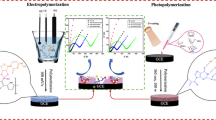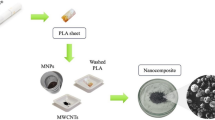Abstract
Because of its widespread distribution in the environment, bisphenol A (BPA) has become a global concern as an endocrine disruptor and a threat to human health through the food chain. Thus an efficient determination method is urgently needed for monitoring the levels of BPA. Herein, a novel electrochemical technique for the detection of BPA was performed by synchronous extraction and pre-concentration of BPA onto magnetic molecularly imprinted polymer (BMMIP), with subsequent readout on a magneto-actuated glassy carbon electrode (MGCE) by differential pulse voltammetry. Compared to the current methods of BPA determination, this BMMIP-based electrochemical sensor (BMMIPs@MGCE) not only simplifies the sample handling procedures substantially, without filtration, centrifugation, or other complex operations, but also can be easily renewed by a controllable magnetic field. As a sensor component, the core–shell BMMIPs exhibited excellent binding capacity (Qe = 82.5 mg g−1), short adsorption equilibrium time (30 s), and outstanding selectivity (k′ = 7.239) towards BPA, as well as stability and recyclability. Importantly, the BMMIPs@MGCE sensor was successfully applied for the on-site monitoring and rapid detection of BPA in complicated real-world specimens, with good recoveries (81.31–119.77%) and a low limit of detection (0.133 μmol L−1). Therefore, the stable and low-cost BMMIPs@MGCE sensor provides a new approach for the rapid determination of BPA in the field of environmental control and food safety.

Graphical abstract






Similar content being viewed by others
References
Björnsdotter MK, de Boer J, Ballesteros-Gómez A. Bisphenol A and replacements in thermal paper: a review. Chemosphere. 2017;182:691–706.
Xiao C, Wang L, Zhou Q, Huang X. Hazards of bisphenol A (BPA) exposure: a systematic review of plant toxicology studies. J Hazard Mater. 2020;384:121488.
Vandenberg LN, Chahoud I, Heindel JJ, Padmanabhan V, Paumgartten FJ, Schoenfelder G. Urinary, circulating, and tissue biomonitoring studies indicate widespread exposure to bisphenol A. Environ Health Perspect. 2010;118(8):1055–70.
Guo R, Du Y, Zheng F, Wang J, Wang Z, Ji R, et al. Bioaccumulation and elimination of bisphenol A (BPA) in the alga Chlorella pyrenoidosa and the potential for trophic transfer to the rotifer Brachionus calyciflorus. Environ Pollut. 2017;227:460–7.
Fu P, Kawamura K. Ubiquity of bisphenol A in the atmosphere. Environ Pollut. 2010;158(10):3138–43.
Kwak JI, Moon J, Kim D, Cui R, An YJ. Determination of the soil hazardous concentrations of bisphenol A using the species sensitivity approach. J Hazard Mater. 2018;344:390–7.
Schug TT, Janesick A, Blumberg B, Heindel JJ. Endocrine disrupting chemicals and disease susceptibility. J Steroid Biochem Mol Biol. 2011;127(3–5):204–15.
Yin H, Cui L, Ai S, Fan H, Zhu L. Electrochemical determination of bisphenol A at mg-Al-CO3 layered double hydroxide modified glassy carbon electrode. Electrochim Acta. 2010;55(3):603–10.
Zhou T, Feng Y, Zhou L, Tao Y, Luo D, Jing T, et al. Selective and sensitive detection of tetrabromobisphenol-A in water samples by molecularly imprinted electrochemical sensor. Sensors Actuators B Chem. 2016;236:153–62.
Ballesteros-Gómez A, Rubio S, Pérez-Bendito D. Analytical methods for the determination of bisphenol A in food. J Chromatogr A. 2009;1216(3):449–69.
Nantaphol S, Chailapakul O, Siangproh W. Sensitive and selective electrochemical sensor using silver nanoparticles modified glassy carbon electrode for determination of cholesterol in bovine serum. Sensors Actuators B Chem. 2015;207:193–8.
Gao Y, Cao Y, Yang D, Luo X, Tang Y, Li H. Sensitivity and selectivity determination of bisphenol A using SWCNT–CD conjugate modified glassy carbon electrode. J Hazard Mater. 2012;199:111–8.
Moreno MJ, D’Arienzo P, Manclús JJ, Montoya Á. Development of monoclonal antibody-based immunoassays for the analysis of bisphenol A in canned vegetables. J Environ Sci Heal B. 2011;46(6):509–17.
Yin H, Zhou Y, Xu J, Ai S, Cui L, Zhu L. Amperometric biosensor based on tyrosinase immobilized onto multiwalled carbon nanotubes-cobalt phthalocyanine-silk fibroin film and its application to determine bisphenol A. Anal Chim Acta. 2010;659(1–2):144–50.
Lu YC, Guo MH, Mao JH, Xiong XH, Liu YJ, Li Y. Preparation of core-shell magnetic molecularly imprinted polymer nanoparticle for the rapid and selective enrichment of trace diuron from complicated matrices. Ecotox Environ Safe. 2019;177:66–76.
Yáñez-Sedeño P, Campuzano S, Pingarrón JM. Electrochemical sensors based on magnetic molecularly imprinted polymers: a review. Anal Chim Acta. 2017;960:1–17.
Han Q, Shen X, Zhu W, Zhu C, Zhou X, Jiang H. Magnetic sensing film based on Fe3O4@ au-GSH molecularly imprinted polymers for the electrochemical detection of estradiol. Biosens Bioelectron. 2016;79:180–6.
Lu YC, Mao JH, Zhang W, Wang C, Cao M, Wang XD, et al. A novel strategy for selective removal and rapid collection of triclosan from aquatic environment using magnetic molecularly imprinted nano−polymers. Chemosphere. 2020;238:124640.
Deng F, Li Y, Luo X, Yang L, Tu X. Preparation of conductive polypyrrole/TiO2 nanocomposite via surface molecular imprinting technique and its photocatalytic activity under simulated solar light irradiation. Colloid Surface A. 2012;395:183–9.
Liu B, Tang D, Zhang B, Que X, Yang H, Chen G. Au(III)-promoted magnetic molecularly imprinted polymer nanospheres for electrochemical determination of streptomycin residues in food. Biosens Bioelectron. 2013;41:551–6.
Miao SS, Wu MS, Zuo HG, Jiang C, Jin SF, Lu YC, et al. Core-shell magnetic molecularly imprinted polymers as sorbent for sulfonylurea herbicide residues. J Agric Food Chem. 2015;63(14):3634–45.
Arabi M, Ghaedi M, Ostovan A. Development of a lower toxic approach based on green synthesis of water-compatible molecularly imprinted nanoparticles for the extraction of hydrochlorothiazide from human urine. ACS Sustain Chem Eng. 2017;5(5):3775–85.
Ji W, Sun R, Duan W, Wang X, Wang T, Mu Y, et al. Selective solid phase extraction of chloroacetamide herbicides from environmental water samples by amphiphilic magnetic molecularly imprinted polymers. Talanta. 2017;170:111–8.
Jiang H, Jiang D, Shao J, Sun X. Magnetic molecularly imprinted polymer nanoparticles based electrochemical sensor for the measurement of gram-negative bacterial quorum signaling molecules (N-acyl-homoserine-lactones). Biosens Bioelectron. 2016;75:411–9.
Zeng H, Wang Y, Liu X, Kong J, Nie C. Preparation of molecular imprinted polymers using bi-functional monomer and bi-crosslinker for solid-phase extraction of rutin. Talanta. 2012;93:172–81.
Hassan AH, Moura SL, Ali FH, Moselhy WA, Sotomayor MDPT, et al. Electrochemical sensing of methyl parathion on magnetic molecularly imprinted polymer. Biosens Bioelectron. 2018;118:181–7.
Xu L, Pan J, Dai J, Li X, Hang H, Cao Z, et al. Preparation of thermal-responsive magnetic molecularly imprinted polymers for selective removal of antibiotics from aqueous solution. J Hazard Mater. 2012;233:48–56.
Abu-Alsoud GF, Hawboldt KA, Bottaro CS. Comparison of four adsorption isotherm models for characterizing molecular recognition of individual phenolic compounds in porous tailor-made molecularly imprinted polymer films. ACS Appl Mater Interfaces. 2020;12(10):11998–2009.
Ji Y, Yin J, Xu Z, Zhao C, Huang H, Zhang H, et al. Preparation of magnetic molecularly imprinted polymer for rapid determination of bisphenol A in environmental water and milk samples. Anal Bioanal Chem. 2009;395(4):1125–33.
Qu Y, Qin L, Liu X, Yang Y. Reasonable design and sifting of microporous carbon nanosphere-based surface molecularly imprinted polymer for selective removal of phenol from wastewater. Chemosphere. 2020:126376.
Tian H, Liu T, Mu G, Chen F, He M, You S, et al. Rapid and sensitive determination of trace fluoroquinolone antibiotics in milk by molecularly imprinted polymer-coated stainless steel sheet electrospray ionization mass spectrometry. Talanta. 2020:121282.
Gao R, Kong X, Wang X, He X, Chen L, Zhang Y. Preparation and characterization of uniformly sized molecularly imprinted polymers functionalized with core-shell magnetic nanoparticles for the recognition and enrichment of protein. J Mater Chem. 2011;21(44):17863–71.
Huang C, Wu Y, Chen J, Han Z, Wang J, Pan H, et al. Synthesis and Electrocatalytic activity of 3Au-1Pd alloy nanoparticles/graphene composite for bisphenol A detection. Electroanalysis. 2012;24(6):1416–23.
Pereira GF, Andrade LS, Rocha-Filho RC, Bocchi N, Biaggio SR. Electrochemical determination of bisphenol A using a boron-doped diamond electrode. Electrochim Acta. 2012;82:3–8.
Gray GM, Cohen JT, Cunha G, Hughes C, McConnell EE, Rhomberg L, et al. Weight of the evidence evaluation of low-dose reproductive and developmental effects of bisphenol A. Hum Ecol Risk Assess. 2004;10(5):875–921.
Acknowledgments
Financial support from the National Key Research and Development Program of China (2018YFC1602800), National Natural Science Foundation of China (21707070), and Natural Science Foundation of Jiangsu Province in China (BK20170998) are gratefully acknowledged. This work was also supported by the Young Talents Project in Jiangsu Province (2019) and Graduate Research and Innovation Projects of Jiangsu Province (KYCX20_1107).
Author information
Authors and Affiliations
Corresponding authors
Ethics declarations
Conflict of interest
The authors declare that they have no conflict of interest.
Additional information
Publisher’s note
Springer Nature remains neutral with regard to jurisdictional claims in published maps and institutional affiliations.
Rights and permissions
About this article
Cite this article
Lu, Y.C., Xiao, W.W., Wang, J.Y. et al. Rapid isolation and determination of bisphenol A in complicated matrices by magnetic molecularly imprinted electrochemical sensing. Anal Bioanal Chem 413, 389–401 (2021). https://doi.org/10.1007/s00216-020-03006-8
Received:
Revised:
Accepted:
Published:
Issue Date:
DOI: https://doi.org/10.1007/s00216-020-03006-8




